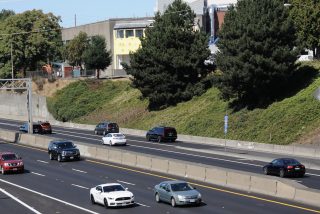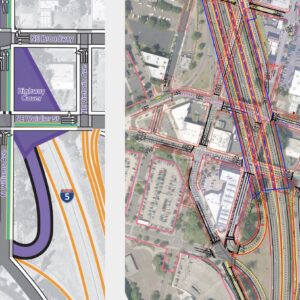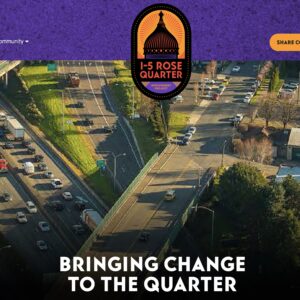
(Photo © J. Maus/BikePortland)
The Oregon Department of Transportation just announced they’ll open a two-week comment period on the controversial I-5 Rose Quarter project.
The news comes a day after revelations that the Oregon Transportation Commission planned to postpone a crucial upcoming meeting where they were slated to vote on whether or not ODOT will perform a more robust Environmental Impact Statement (EIS). As The Oregonian reported yesterday, they postponed their scheduled March 20th meeting to April 2nd and announced it would be held via telephone due to the coronavirus outbreak.
Concerned Portlanders with No More Freeways (and BikePortland) worried that this meeting would be inaccessible to the public and a violation of Oregon public meeting law. ODOT heard those concerns and just announced the following:
During its April 2 meeting, the OTC will receive updates on the I-5 Rose Quarter Improvement Project and provide information to ODOT regarding the project’s environmental review. Due to the changes in timing and format of the OTC meeting and to ensure access for anyone who would like to provide public testimony on the Rose Quarter Improvement Project* or other agenda items, ODOT is opening a two week public comment period beginning Monday, March 16, 2020 and continuing through 5 p.m. PDT on Friday, March 27, 2020.
Advertisement
The meeting will also be streamed live on ODOT’s YouTube channel.
As for the comments, the OTC says they’d like to hear specifically whether they should direct ODOT to conduct the EIS or stick with the existing (and less thorough) Environmental Assessment.
There are three ways to share your comments: Submit them over the web via OTC’s website; mail them to the OTC at 355 Capitol Street NE, MS 11, Salem OR 97301; or schedule a timeslot and put your comments on video at ODOT Region 1 HQ in Portland (contact OTCAdmin@odot.state.or.us to set up a time to record).
While it’s a nice gesture to allow more public comment on this issue, it’s also a bit strange. Thanks in large part to No More Freeways and other activist groups, ODOT and the OTC have already received thousands of comments and letters on this subject.
In related news, we’re waiting to hear from ODOT about who’s been chosen to serve on the project’s Community Advisory Committee. ODOT made their selections on March 1st and has notified all applicants; but they’ve yet to release the final roster. Stay tuned for that.
— Jonathan Maus: (503) 706-8804, @jonathan_maus on Twitter and jonathan@bikeportland.org
— Get our headlines delivered to your inbox.
— Support this independent community media outlet with a one-time contribution or monthly subscription.






Thanks for reading.
BikePortland has served this community with independent community journalism since 2005. We rely on subscriptions from readers like you to survive. Your financial support is vital in keeping this valuable resource alive and well.
Please subscribe today to strengthen and expand our work.
Maddening.
“they’d like to hear specifically whether they should direct ODOT to conduct the EIS or stick with the existing (and less thorough) Environmental Assessment.”
Of course! To disqualify those comments which oppose the whole thing, right from the start.
My vote is for conducting the EIS and hiring an impartial third party to do it via a public process of some sort.
The environmental part of the project that is overlooked? The HUGE carbon footprint from all the cement that will be needed.
If the cement industry were a country, it would be the third largest emitter in the world – behind China and the US. It contributes more CO2 than aviation fuel (2.5%) and is not far behind the global agriculture business (12%).
Yes, building a big city modern typically takes a lot of concrete and that produces GHG. The production of concrete, alone, produces 8 percent of GHG. Sidewalks, big foundations for big buildings, big concrete condo buildings. And then people working in service industries where the big building is climate controlled year round—and PGE still gets 60 percent of its power from fossil fuels, mainly natural gas.
Of course, we like to get mad at the tradesman who burns gasoline in his old truck, but keeps warm by actually DOING something. Or the small businesswoman scooting around in her Honda Civic. Ah yes, the new urbanists have all of the answers.
The lighter traffic this week didn’t make any difference to my bike commute but people at my work who drive where in total shock at the lack of commute hour traffic. Some people who just work at their computer and don’t really need to be on-site all the time where given the option to work at home some days, and I heard other companies were doing the same. Some were worried this might impact productivity, but actually it was a very productive week for the factory. If anything it seemed to improve productivity so far.
My point is that it only took a slight adjustment to allow select people to work from home some of the time to result in a drastic reduction in commute hour traffic, with no apparent downside. This demonstrates that the trillions we have spent locally on freeways over time is in large part to support the employer inflexibility of unnecessarily requiring everyone showing up at the exact same time when other options are available.
Congestion pricing if applied to commute hours may force some workers to ask their employers to allow them to shift their schedule but why not just just directly apply the pressure to medium and large size employers. Employers could be incentivized by a headcount congestion impact fee, that they could then get out of paying if they shifted a certain amount of workers at least slightly off 8 to 5, or allowed some workers to work from home a certain percent of time, or set up car pooling program for employees and demonstrate a increase in carpooling. The answer should not be widen widen widen every time.
Comment of the week – especially this part:
“This demonstrates that the trillions we have spent locally on freeways over time is in large part to support the employer inflexibility of unnecessarily requiring everyone showing up at the exact same time when other options are available.”
Since we are in a state of emergency, what if we took the funds targeted to this project and put them to testing for COVID19 as well as paying for people to take paid sick leave so more of us survive the pandemic?
A nice gesture, but my hunch would be that we don’t actually have the money. The rules that disallowed borrowing for this kind of ODOT nonsense were changed within the last decade. Now Much of these (public) games involve tons of interest that all wander into the pockets of the (private) banks.
Oregon has a silly and unique law that basically says that any transportation revenue raised with gas taxes and vehicle registration fees must be spent on transportation projects. No other state has that law. (Mind you, the other 49 states have equally silly laws. My state passed a gas tax increase that was supposed to go for highways, but 100% of the revenue collected went instead to expand university campuses, including building parking lots and parking garages.)
If this whole project wasn’t so laden with urban renewal goodies it might deserve a community advisory board, even though no other such board has been organized at other Interstate system projects in Oregon. Did Troutdale and Fairview form a “community advisory board” regarding the I-84 improvement over the Sandy River and Graham Rd? What if Tualatin, Durham or Metzger had done it to halt recent improvements to I-5 in their area?
This is an urban renewal plan that has been in the works for ten years. Portland should have asked for an EIS years ago (and METRO could have done the same), if they thought it was appropriate. Instead of waiting until the last minute. The other major representation going around is that this is a nearly “$1 billion freeway expansion.” (You know who I am taking about). It is not. The Lion’s share is an urban renewal project. Sen. Lee Beyers (D-Springfield) stated:“If Portland wants to put lids and all that kind of stuff on freeways . . . we’re not paying for it, That’s a local decision, local desire … It’s not part of the state highway system.” (quoted on OPB).
Sorry kids. You wanted a big city. It’s here now.
Speaking of Portland being a big city, in this era of cheap oil ($32/barrel last I checked, less than half of what it was 6 months ago), there’s really nothing legal to stop a citizen-lead referendum to raise gas taxes by a significant amount, and require all the funds to be used to pay for the 2030 bike plan. Just sayin’…
I just submitted a comment via the website in favor of a full EIS, and if nothing else, you should too. It took less than a minute.
Thanks for the link, Jonathan.
I submitted a quick comment to the OTC –
Dear OTC,
As you are very aware, we as a state and a country and a population have very little time to drastically reduce our carbon emissions.
As you are also surely aware, Oregon’s Global Warming Commission has reported that the state is nowhere near it’s goals currently.
And finally, I’m sure you’re aware that the plan for the Rose Quarter project always included a congestion pricing element which has the exciting potential of decreasing carbon emissions without widening the freeway at all.
Given these three simple facts, I hope you will see the benefit in starting an immediate congestion pricing trial to determine to what extent that component of the project alone could reduce carbon emissions, and upon completion of the test period, including the knowledge gained from that trial into a full EIS for the Rose Quarter project.
Such a strategy presents the alluring opportunity to save money (something extra import in light of a likely global recession caused by COVID-19) while performing due diligence and protecting the planet.